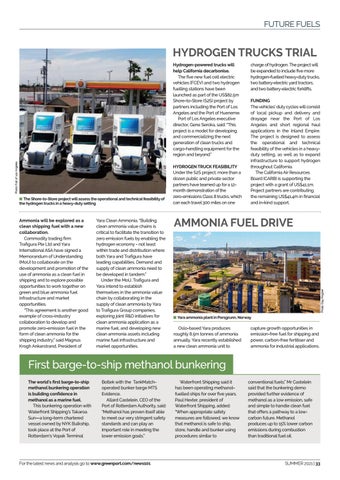FUTURE FUELS
HYDROGEN TRUCKS TRIAL
8 The Shore-to-Store project will assess the operational and technical feasibility of the hydrogen trucks in a heavy-duty setting
Ammonia will be explored as a clean shipping fuel with a new collaboration. Commodity trading firm Trafigura Pte Ltd and Yara International ASA have signed a Memorandum of Understanding (MoU) to collaborate on the development and promotion of the use of ammonia as a clean fuel in shipping and to explore possible opportunities to work together on green and blue ammonia fuel infrastructure and market opportunities. “This agreement is another good example of cross-industry collaboration to develop and promote zero-emission fuel in the form of clean ammonia for the shipping industry,” said Magnus Krogh Ankarstrand, President of
Yara Clean Ammonia. “Building clean ammonia value chains is critical to facilitate the transition to zero emission fuels by enabling the hydrogen economy - not least within trade and distribution where both Yara and Trafigura have leading capabilities. Demand and supply of clean ammonia need to be developed in tandem.” Under the MoU, Trafigura and Yara intend to establish themselves in the ammonia value chain by collaborating in the supply of clean ammonia by Yara to Trafigura Group companies, exploring joint R&D initiatives for clean ammonia application as a marine fuel, and developing new clean ammonia assets including marine fuel infrastructure and market opportunities.
HYDROGEN TRUCK FEASIBILITY Under the S2S project, more than a dozen public and private sector partners have teamed up for a 12month demonstration of the zero-emissions Class 8 trucks, which can each travel 300 miles on one
charge of hydrogen. The project will be expanded to include five more hydrogen-fuelled heavy-duty trucks, two battery-electric yard tractors, and two battery-electric forklifts. FUNDING The vehicles' duty cycles will consist of local pickup and delivery and drayage near the Port of Los Angeles and short regional haul applications in the Inland Empire. The project is designed to assess the operational and technical feasibility of the vehicles in a heavyduty setting, as well as to expand infrastructure to support hydrogen throughout California. The California Air Resources Board (CARB) is supporting the project with a grant of US$41.1m. Project partners are contributing the remaining US$41.4m in financial and in-kind support.
AMMONIA FUEL DRIVE
Photo: Dag Frogner
Photo: Port of Los Angeles
Hydrogen-powered trucks will help California decarbonise. The five new fuel cell electric vehicles (FCEV) and two hydrogen fuelling stations have been launched as part of the US$82.5m Shore-to-Store (S2S) project by partners including the Port of Los Angeles and the Port of Hueneme. Port of Los Angeles executive director, Gene Seroka, said: “This project is a model for developing and commercializing the next generation of clean trucks and cargo-handling equipment for the region and beyond.”
8 Yara ammonia plant in Porsgrunn, Norway
Oslo-based Yara produces roughly 8.5m tonnes of ammonia annually. Yara recently established a new clean ammonia unit to
capture growth opportunities in emission-free fuel for shipping and power, carbon-free fertiliser and ammonia for industrial applications.
First barge-to-ship methanol bunkering The world's first barge-to-ship methanol bunkering operation is building confidence in methanol as a marine fuel. This bunkering operation with Waterfront Shipping's Takaroa Sun—a long-term chartered vessel owned by NYK Bulkship, took place at the Port of Rotterdam's Vopak Terminal
Botlek with the TankMatchoperated bunker barge MTS Evidence. Allard Castelein, CEO of the Port of Rotterdam Authority, said: “Methanol has proven itself able to meet our very stringent safety standards and can play an important role in meeting the lower emission goals.”
For the latest news and analysis go to www.greenport.com/news101
Waterfront Shipping said it has been operating methanolfuelled ships for over five years. Paul Hexter, president of Waterfront Shipping, added: “When appropriate safety measures are followed, we know that methanol is safe to ship, store, handle and bunker using procedures similar to
conventional fuels.” Mr Castelein said that the bunkering demo provided further evidence of methanol as a low emission, safe and simple to handle clean fuel that offers a pathway to a lowcarbon future. Methanol produces up to 15% lower carbon emissions during combustion than traditional fuel oil.
SUMMER 2021 | 33








